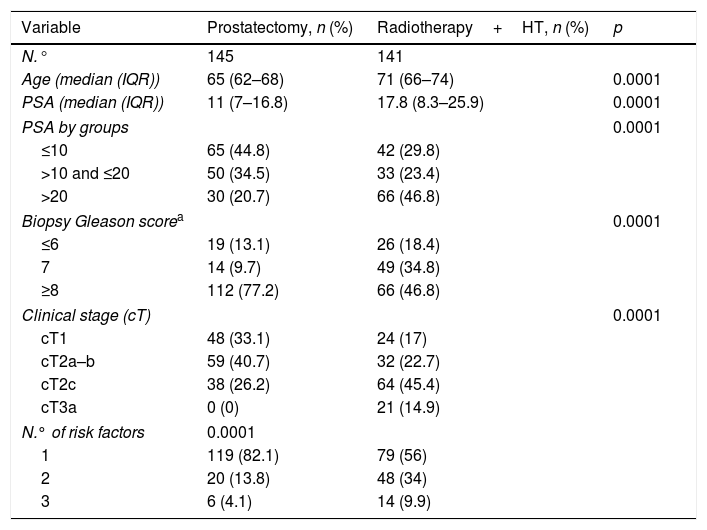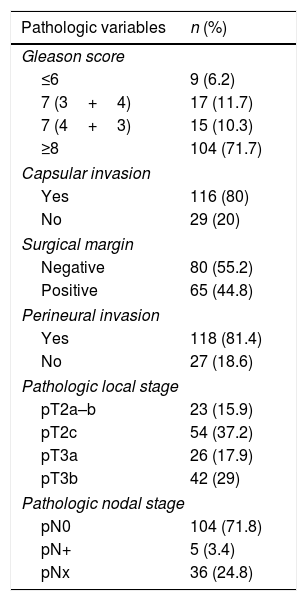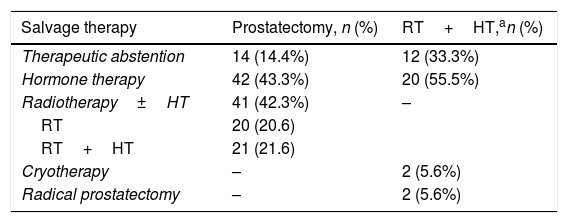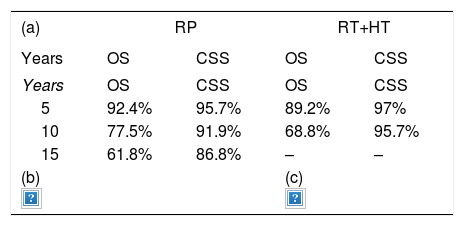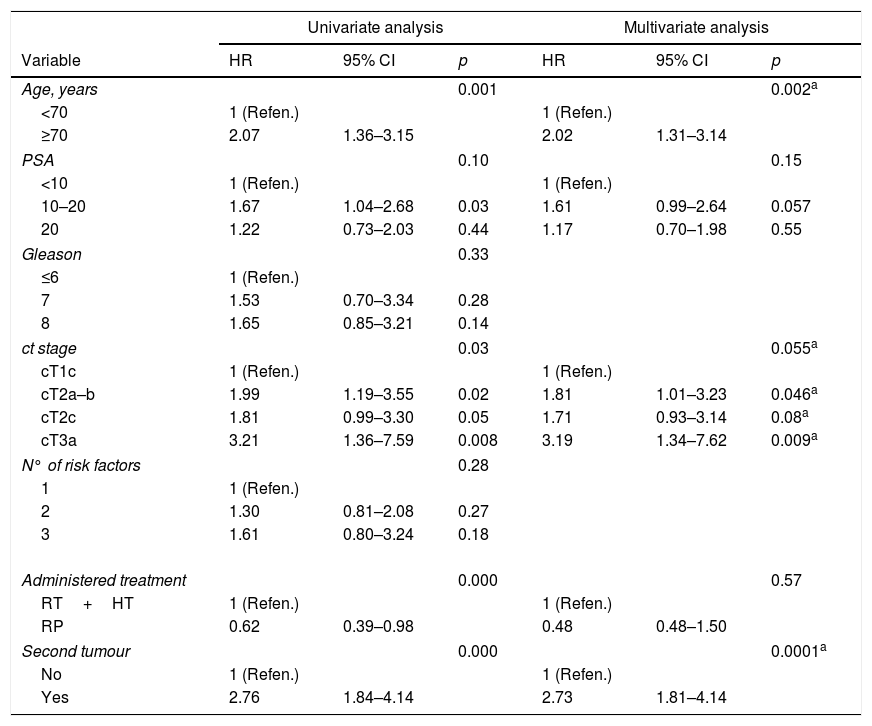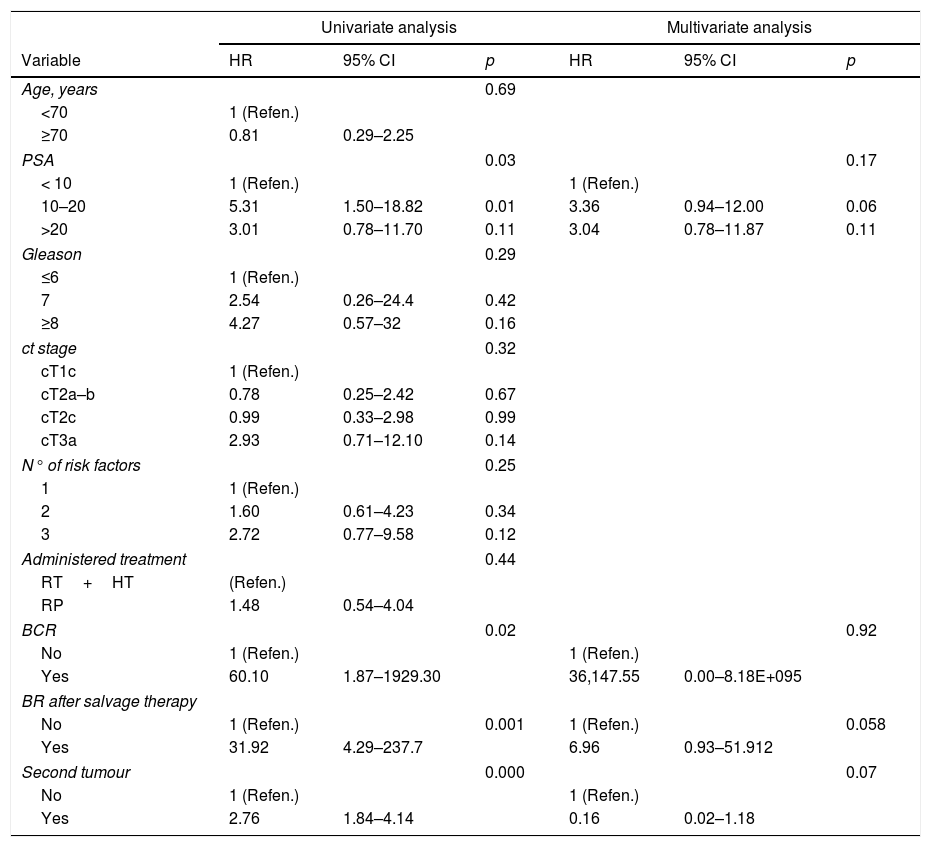There is no high-level evidence as to which primary treatment provides an overall survival (OS) or cancer-specific survival (CSS) advantage in high-risk localised prostate cancer (HRLPC).
Our aim was to analyse the differences in survival and predictive factors in this group of patients, according to their primary treatment (radical prostatectomy (RP) or radiotherapy and androgen blockade (RT+HT)).
Material and methodsA retrospective study of 286 HRLPC patients diagnosed between 1996 and 2008, treated by RP (n=145) or RT+HT (n=141).
Survival was assessed using the Kaplan–Meier method. Significant differences between the different variables were analysed using the log-rank test. A uni and multivariate Cox regression analysis was performed to identify risk factors.
ResultsThe median follow-up was 117.5 (IQR 87–158) months. The OS was longer (p=0.04) in the RP patients, while there were no differences (p=0.44) in CSS between either group.
The type of primary treatment was not related to OS or CSS. Age (p=0.002), the onset during follow-up of a 2nd tumour (p=0.0001), and stage cT3a (p=0.009) behaved as independent predictive variables of OS. None of the variables behaved as an independent predictive variable of CSS, although biochemical recurrence after rescue treatment (p=0.058), and the onset of a 2nd tumour during follow-up showed a significant trend to statistical significance, the latter reducing specific cancer mortality (HR .16, 95%CI 0.02–1.18, p=0.07).
ConclusionsPrimary treatment did not relate to OS or CSS in patients with HRPC.
No existe evidencia de alto nivel sobre qué tratamiento primario proporciona una ventaja de supervivencia global (SG) y supervivencia cáncer específica (SCE) en cáncer de próstata localizado de alto riesgo (CPAR).
Nuestro objetivo es analizar las diferencias en supervivencia, así como sus factores predictores, en este grupo de pacientes según su tratamiento primario (prostatectomía radical [PR] o radioterapia y bloqueo androgénico [RT+HT]).
Material y métodosEstudio retrospectivo de 286 pacientes con CPAR diagnosticados entre 1996-2008, tratados mediante PR (n=145) o RT+HT (n=141).
La supervivencia se evaluó con el método de Kaplan-Meier. La existencia de diferencias significativas entre las distintas variables se analizó mediante el test de log-rank. Para la identificación de factores de riesgo se utilizó un análisis uni y multivariante mediante regresión de Cox.
ResultadosLa mediana de seguimiento fue de 117,5 (IQR 87-158) meses. La SG fue mayor (p=0,04) en los pacientes con PR, mientras que no existieron diferencias (p=0,44) en la SCE entre ambos grupos.
El tipo de tratamiento primario no se relacionó con la SG ni SCE. La edad (p=0,002), la aparición durante el seguimiento de un segundo tumor (p=0,0001) y el estadio cT3a (p=0,009) se comportaron como variables predictoras independientes de SG. Ninguna de las variables se comportó como variable predictora independiente de SCE, aunque la recidiva bioquímica tras tratamiento de rescate (p=0,058) y la aparición de un segundo tumor durante el seguimiento presentaron una tendencia importante a la significación estadística, reduciendo este último la mortalidad cáncer específica (hazard ratio 0,16, intervalo de confianza del 95% 0,02-1,18, p=0,07).
ConclusionesEl tratamiento primario no se relacionó con la SG ni SCE en pacientes con CPAR.
Artículo
Comprando el artículo el PDF del mismo podrá ser descargado
Precio 19,34 €
Comprar ahora






